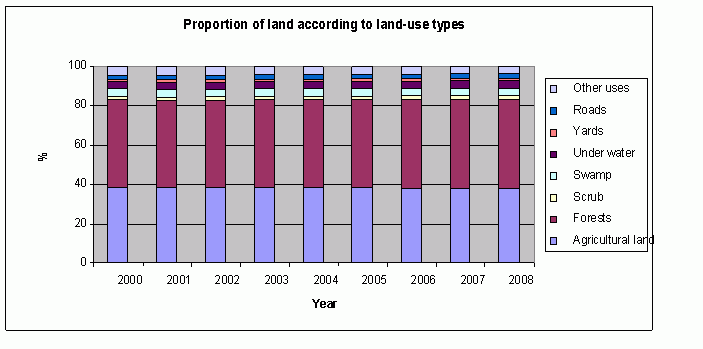Published: 26 Nov 2010
Modified: 11 May 2020
State
In recent years, Latvia
has experienced a significant trend towards the abandonment of agricultural
land, caused by the unfavourable economic situation in the agricultural sector,
rural-to-urban migration and the ageing of the rural population. As a result, the
most important feature of the Latvian landscape - the countryside - has suffered
negative effects. Moreover, due to the current economic recession, there is evidence
that the trend towards abandonment and migration are increasing and there is a risk
that certain areas will eventually become depressed.
The second trend is towards urban
sprawl. During the years of economic growth, there was a tendency to build
family houses in the suburbs and commute to work in cities. The urban sprawl
caused a reduction in natural areas and landscape fragmentation and these
problems still remain, even though the period of economic expansion is now over.
The third trend is towards the
depletion of natural resources. During a period of economic decline, there is a
tendency to engage in actions that generate short-term income. This may take
the form of intensive timber harvesting or the depletion of mineral deposits
and peat resources.
According
to Latvia’s Annual Land
Report, 2008, the proportion of different land-use types has not changed radically
since 1995. In recent years, the proportion of agricultural land fell slightly,
while the proportion of forests and yard areas
increased. This is connected to afforestation and the transformation of agricultural
land for development. Almost half of Latvia’s territory is covered in forest
(45.7 %). Agricultural
land covers 37.7 % while yard areas only account for 1.5 %.
Dynamics
of land structure according to types of land use
(%
of total state area)
|
Year
|
Agricultural land
|
Forests
|
Scrub
|
Swamp
|
Under water
|
Yards (including built-up areas)
|
Roads
|
Other uses
|
|
2000
|
38.5
|
44.4
|
1.9
|
4.2
|
3.3
|
1.4
|
1.9
|
4.4
|
|
2001
|
38.4
|
44.3
|
1.8
|
4.0
|
3.5
|
1.4
|
2.0
|
4.6
|
|
2002
|
38.3
|
44.5
|
1.8
|
4.0
|
3.5
|
1.4
|
2.0
|
4.5
|
|
2003
|
38.3
|
44.7
|
1.8
|
3.9
|
3.6
|
1.4
|
2.0
|
4.3
|
|
2004
|
38.2
|
45.0
|
1.8
|
3.8
|
3.6
|
1.4
|
2.1
|
4.1
|
|
2005
|
38.1
|
45.2
|
1.8
|
3.9
|
3.6
|
1.4
|
2.1
|
3.9
|
|
2006
|
38.0
|
45.4
|
1.8
|
3.9
|
3.6
|
1.4
|
2.1
|
3.8
|
|
2007
|
37.9
|
45.5
|
1.8
|
3.9
|
3.7
|
1.4
|
2.1
|
3.7
|
|
2008
|
37.7
|
45.7
|
1.8
|
3.9
|
3.7
|
1.5
|
2.1
|
3.6
|
When plotted in the diagrams below,
these data show that there are no relevant changes in the proportions of land-use
types.

The proportion of
land use types in 2008 appears in the diagram below:

Research carried out by the
Ministry of Agriculture in cooperation with the Latvian Rural Consulting and
Education Centre indicates that in 2005 the area of abandoned agricultural land
was 14 % of total agricultural
land area, which is 3.6 % more than in 1995.
According to the Rural Support
Service,
1 566 048 hectares
(64 %) of all agricultural land was declared in applications for payments
under the EU’s Single Area Payment Scheme in 2008. Only 1 051 458 hectares (67 %)
of this land was involved in agricultural production. It is assumed that the
rest of the area declared (514 590 hectares) is being maintained in a good
agricultural and environmental state in order to receive the relevant financial
support. However,
agricultural land management is not monitored extensively and therefore comprehensive
information is not available.
Impacts
The development of rural areas
and agricultural land for construction purposes not only reduces natural areas
and changes usage but also has an influence on the environment. This development
leads to land degradation (e.g. landscape re-naturalisation, fragmentation and
afforestation), contributes to a reduction in biodiversity and exacerbates the problem
of inadequate infrastructure.
The depopulation of rural
areas leads to agricultural land abandonment and degradation. At present, the characteristic
features of rural areas in Latvia
are re-naturalisation, a homogeneous landscape and afforestation.
On the other hand,
agricultural land abandonment also causes a decrease in agricultural run-off
and, as a result, reduced eutrophication in water bodies. Nevertheless, research
has shown that in the long term, agricultural land abandonment reduces biodiversity.


Document Actions
Share with others